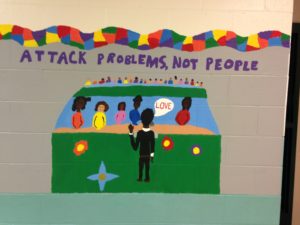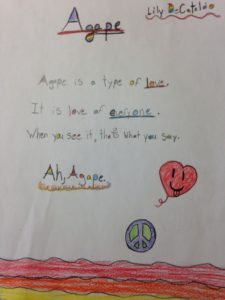
This summer, the Metta Center for Nonviolence is hosting a series on nonviolence education and building community that particularly focuses on how and why nonviolence can be particularly effective for reconciling conflict in schools. Special guest Robin Wildman, a nonviolence educator from Broad Rock Middle School in Rhode Island with 25 years of teaching experience, leads this three-part series on June 9th, July 14th, and August 4th from 5 – 6pm PST (Register here!). Topics include breaking down conflict, understanding core nonviolence principles, and reconciling conflict.
Throughout, participants are encouraged to read:
Letter from a Birmingham Jail and King’s Pilgrimage to Nonviolence.
We also invite participants to continue engaging with each other and the material by using the comments section of this blog post. To support engagement, we encourage participants to review a summary of the call provided below and consider some relevant questions provided at the end of this post.
On Call #2 (Thursday, July 21, 2016), our theme was Six Principles of Nonviolence: A brief explanation of Dr. King’s work from 1955-1968 and his journey to nonviolence, with a focus on Chapter 6, Pilgrimage to Nonviolence, in his first book, Stride for Freedom.
Click here to listen to the recording!
And click here for the full set of Joseph’s notes from the call!
Thanks so the students of Broad Rock Middle School for images of the poetry and art we used below.
Highlights from Call #2:
Robin provided some background on the reading, Pilgrimage to Nonviolence, in his first book, Stride for Freedom. King wrote this book, his first, following the Montgomery bus boycott when he was 26 years old, and this chapter outlines his personal and intellectual journey to discover a philosophy of nonviolence and make that philosophy relevant to all of us, through his Six Principles.
Principle 1: Nonviolence is a way of life for courageous people
- To clarify, nonviolence is a method of resistance – it is active
- It is a strategy that takes hard work, ingenuity, and us trying our best
- Dr. King cites Gandhi and states that “No individual or group need submit to any wrong, nor need they use violence to right the wrong; there is the way of nonviolence resistance. This is ultimately the way of the strong man.”
Principle 2: The beloved community is the framework for the future
- It’s important to understand how actions are connected to a goal or vision for a greater good
- From this, comes hope that all actions, thoughts, and behaviors contribute to a beloved community
- This principle “does not seek to defeat or humiliate the opponent, but to win his friendship and understanding.” And, “they are the means to awaken a sense of moral shame in the opponent.”
Principle 3: Attach forces of evil not the persons doing the evil
- We seek to defeat evil, and not the persons victimized by evil.
- There is a separate of the person, who is capable of kindness and love, from an evil or harmful deed.

Principle 4: Accept suffering without retaliation for the sake of the cause to achieve a goal
- Unearned suffering is redemptive
- Suffering has tremendous education and transforming possibilities
- King cites Gandhi, “things of fundamental importance to people are not secured by reason alone, but have to be purchased with their suffering.” And, “suffering is infinitely more powerful than the law of the jungle for converting the opponent and opening his ears which are otherwise shut to the voice of reason.”
Principle 5: Avoid internal violence of the spirit as well as external physical violence
- At the center of nonviolence stands the principle of love.
- We don’t want to inspire/inflict emotional harm on others, either.
- We can instead, engage in Agape love – “means understanding, redemptive good will.” And, “it is an overflowing love which is purely spontaneous, unmotivated, groundless, and creative. It is disinterested love. It is a love in which the individual seeks not his own good, but the good of his neighbor [sic].”
- “It springs from the need of the other person – his need for belonging to the best in the human family.”
- Nonviolence resistance refuses to physically harm an opponent but also refuses to hate the opponent.
- The agape practitioner loves people for the people they become
Principle 6: The universe is on the side of justice.
- Consequently. The believer in nonviolence has deep faith in the future.
- This faith is another reason why the nonviolence resister can accept suffering without retaliation.
- King states: “There is a creative force in this universe that works to bring the disconnected aspects of reality into a harmonious whole.”

Here is Robin’s “kid-friendly” version of the six principles that she uses in the classroom, which she developed with the consent and approval of Dr. Bernard Lafayette:
1.) Nonviolence is a way of life for brave people
2.) The peaceful community is the goal for the future
3.) Attack problems, not people
4.) Know and do what is right even if it is difficult
5.) Avoid hurting the spirit and body of yourself and others
6.) The universe is on the arc of justice.
These principles can be used and employed in many ways in the classroom. Some examples include:
- Reading these ever day over the loud speaker to students
- Focus on one principle per month
- Can be sent home to parents in pamphlets to be reinforced and practiced together at home
- Use the principles to guide students in coming up with solutions to conflicts they have at school. Kids are smart!
For those interested. King was inspired by Hegel’s enunciation of his dialectic. To learn more about how he was influenced please click here and here.
Questions for reflection:
1.) What are ways in which you have or could use these principles at school?
2.) What are strengths and practices already in your school that might be benefit from using these principles more explicitly?
3.) What are challenging experiences that you’ve faced that make applying these principles extraordinarily difficult? What are some possible creative and alternative ways to face these challenges?
4.) Given examples of nonviolence principles (here, here, and here), how might you investigate other principles of nonviolence and compare the meaning of those to the Kingian Principles?
We encourage any and all educators to engage with the material presented above in the comments section below. We hope to have a lively digital conversation in between our scheduled conversations so that we might address emergent issues as they arise!
Thanks for your participation!








